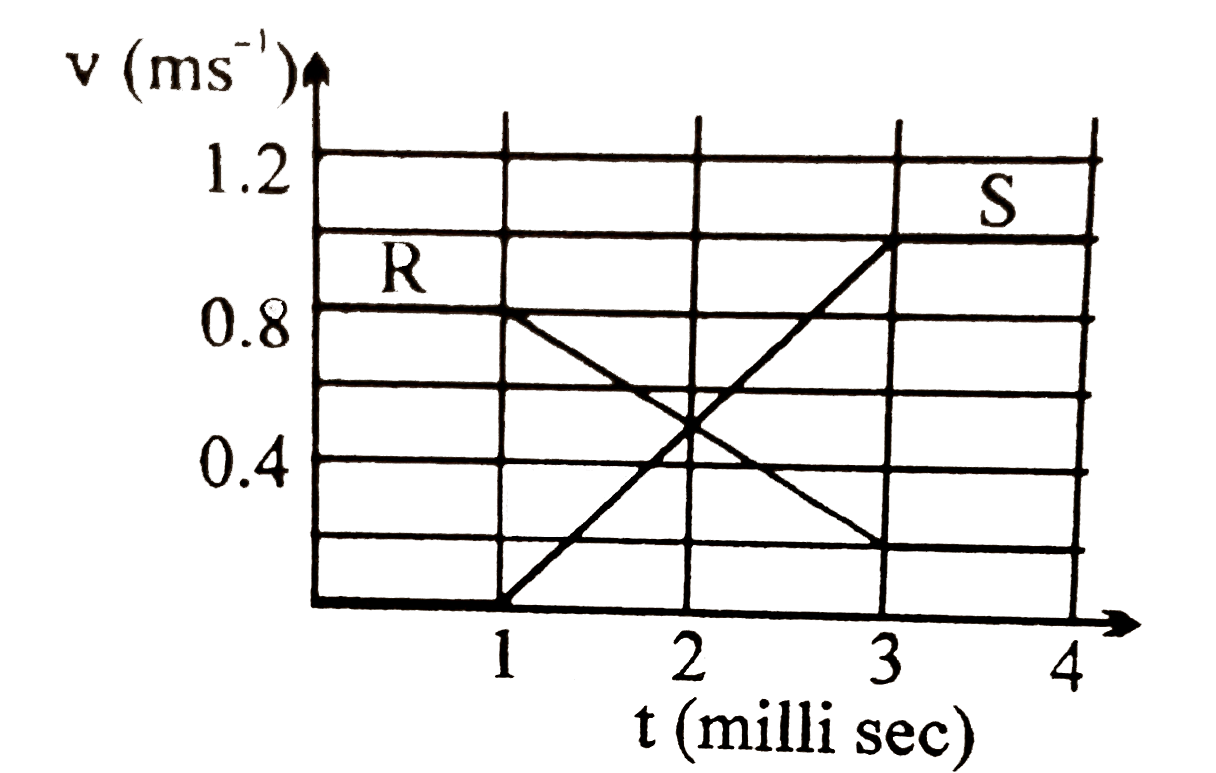Figure shows the velocity-time graph for two masses R and S that collided elastically. Which of the following statements is true?

i. R and S moved in the same direction after the collision.
ii. The velocities of R and S were equal at the mid time of the collision.
iii. The mass of R was greater than mass of S.
Which of the following is true? Solution in Gujrati
I only
II only
I and II only
I, II and III
The correct Answer is:D
COLM:mR(0.8)+mR(0.2)+mS(1.0)
⇒0.6mR=mS⇒mR>mS
Topper's Solved these Questions
- CENTRE OF MASSBOOK - ALLEN CHAPTER - CENTRE OF MASSEXERCISE - EXERCISE-III
41 Videos
- CENTRE OF MASSBOOK - ALLEN CHAPTER - CENTRE OF MASSEXERCISE - EXERCISE-IV A
32 Videos
- CENTRE OF MASSBOOK - ALLEN CHAPTER - CENTRE OF MASSEXERCISE - EXERCISE-I
40 Videos
- BASIC MATHEMATICS USED IN PHYSICS &VECTORS BOOK - ALLEN CHAPTER - BASIC MATHEMATICS USED IN PHYSICS &VECTORS EXERCISE - EXERCISE-IV ASSERTION & REASON
11 Videos
- ELASTICITY, SURFACE TENSION AND FLUID MECHANICSBOOK - ALLEN CHAPTER - ELASTICITY, SURFACE TENSION AND FLUID MECHANICSEXERCISE - Exercise 5 B (Integer Type Questions)
3 Videos
Similar Questions
A particle of mass m, kinetic energy K and momentum p collision head on elastically with another particle of mass 2m at rest. After collision. :
Column IColumn II(A)Momentum of first particle(p)3/4p(B)Momentum of second particle(q)−K/9(C)Kinetic energy of first particle(r)−p/3(D)Kinetic energy of second particle(s)8K9None
View SolutionFig. shown a uniform square plate from identical squares at the corners can be removed. (a) Where is the centre of mass of the plate originally ? (b) Where is it after square 1 is removed ?
(c ) where is it after squares 1 and 2 are removed ? (d) Where is c.m after squares 1,2,3, are removed ?
(f) Where is c.m after all the four squares are removed ? Answer in terms of quadrants and axes.

View SolutionThe centre of mass of a non uniform rod of length L whoose mass per unit length varies as p=kx2/L, (where k is a constant and x is the distance measured form one end) is at the following distances from the same end
View SolutionAssertion: If the initial and final positions coincide, the displacement is a null vector.
Reason: A physical quantity can not be called a vector, if its magnitude is zero.
View SolutionTwo soap bubbles A and B are kept in a closed chamber where the air is maintained at pressure 8N/m2.The radii of bubbles A and B are 2cm and 4cm, respectively. Surface tension of the soap-water used to make bubbles is 0.04N/m. Find tha ratio nB/nA, where nA and nB are the number of moles of air in bubbles A and B, respectively. [Neglect the effect of gravity.]
View SolutionFigure shows the velocity-time graph for two masses R and S that collided elastically. Which of the following statements is true? i. R and S moved in the same direction after the collision. ii. The velocities of R and S were equal at the mid time of the collision. iii. The mass of R was greater than mass of S . Which of the following is true?
View SolutionTwo perfectly elastic particles A and B of equal masses travelling along a line joining them with velocities 15 m//s and 10m//s respectively collide. Their velocities after the elastic collision will be (in m/s) respectively
View SolutionThe diagram to the right shows the velocity-time graph for two masses R and S that collided elastically. Which of the following statements is true?
[I] R and S moved in the same direction after the collision.
[II] Kinetic energy of the system (R & S) is minimum at t=2 milli sec.
[III] The mass of R was greater than mass of S.

View SolutionThe diagram shows the velocity - time graph for two masses R and S that collided elastically. Which of the following statements is true ? I. R and S moved in the same direction after the collision. II. The velocities of R and S were equal at the mid time of the collision. III. The mass of R was greater than mass of S.
View SolutionTwo particles of equal mass moving towards each other with velocities 20 m*s^(-1) and 30 m*s^(-1) collide. If the collision is elastic, find their velocities after the collision.
View SolutionTwo balls of equal masses movin with velocities 10m/s and -7m/s respectively collide elatically. There velocities after collision with be
View SolutionPutty balls of two equal mass cling to each other after a collision, moving in the same perpendicular direction. If the balls are initially 45sqrt2m//s Find the velocity of their combined mass after the collision if they were moving with velocity.
View SolutionA steel sphere of mass 100 gm moving with a velocity of 4m/s collides with a dust particle elastically moving in the same direciton with a velocity of 1m/s. The velocity of the dust particle after the collision is
View SolutionA sphere of mass 0.3kg moving with a velocity of 4m/s collides with another sphere of mass 0.5kg which is at rest. Assuming the collision to be elastic, their velocities after the impact are
View SolutionA steel sphere of mass 100gm moving with a velocity of 4m/s collides with a dust particle elastically moving in the same direction with a velocity of 1m/s. The velocity of the dust particle after the collision is (dust partical is of mass neglisiable
View SolutionTwo perfectly elastic spheres of masses 4kg and 6kg moving in opposite directions with velocities of 4m/s and 6m/s collide with each other. Their velocities after head on collision are
View Solution
